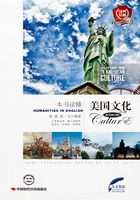
第9章 美国的由来(3)
清教徒建立的另外一个殖民地是宾夕法尼亚殖民地,它是由来自清教中贵格宗的领袖威廉·佩恩建立的,贵格宗教徒拒绝宣誓并拒绝服兵役,很快为英国政府所不容,大量的教徒纷纷移民到北美。佩恩的父亲是英国著名的军事将领,佩恩本人也很有能力,1681年3月14日,他从英国国王查理一世那里获得了特许状,拥有了宾夕法尼亚地区土地的所有权,1682年,佩恩建立了费城,这个名字是他用两个希腊词合成的,表达了他计划进行和睦相处的神圣实验的良好愿望。佩恩施行的宗教自由政策以及他公正处事的良好声誉,很快吸引了大量来自欧洲的移民,其中很多是来自德国为躲避宗教迫害的新教小派别的教徒。从1607年到1733年间,英国在北美的东海岸建立了13个殖民地。
3.The First Immigrant: "Pilgrims" in the Mayflower(1620) 最初的移民:五月花号船上的“朝圣者”
The Mayflower(It's also a name of a flower. Massachusetts adopted the mayflower as the official flower of the state to commemorate the Pilgrims)was a ship.It is most famous for its maiden[9] voyage(first voyage)when pilgrims and other settlers travelled on it to the New World.Not until September 6, 1620,did the Mayflower carried 102 men, women and children, who lived in the dark, damp, cold cargo decks below the crew's quarters set sail for America.As the fishermen of the day knew all too well, September was the time to seek safe harbors for winter and one of the worst times to be setting sail upon an uncertain ocean.Undoubtedly, the Pilgrims had been warned of the dangers which they would face in the North Atlantic if they insisted on beginning their voyage at that time of year.However, their money was at an end.They had no choice but to continue.Master Christopher Jones, the skipper[10], had sailed the waters of the North Sea during stormy seasons, and he knew how to handle Mayflower under such stressful weather conditions.
For 66 storm-tossed days the Pilgrims suffered their passage across a wintry Atlantic Ocean to the New World. On Saturday, November 21,the ship moored in what would come to the present-day Massachusetts.Upon the arrival, those Pilgrims realized that they were on a land uncharted by the English crown, in order to survive and protect themselves from rebels, they signed the historic Mayflower Compact, the first formal agreement for self-government in America.Then the Pilgrims decided to settle in Plymouth, far southward of where they had landed.
五月花(有种花就叫做“五月花”,马萨诸塞州为了纪念朝圣者们而把五月花定为州花)号是一艘船。因其处女航(首航)是载着朝圣者前往新大陆而著称。直到1620年9月6日,五月花载着男人、妇女和儿童共102人,他们挤在黑暗、潮湿、冰冷的船员宿舍的甲板上开始了去往美国的旅程。当时所有的渔民都很清楚,9月是为冬季寻求安全港的时节,对于未知的远洋航行来说是最为恶劣的时间。毫无疑问,朝圣者也知道如果坚持这个时间启程,他们将在北大西洋面临很大的危险。然而,他们的经费已经濒临紧张,只有继续下去,别无选择。船长克里斯托弗·琼斯是把好手,曾经在暴风雨季节横穿北海水域,他知道如何在紧张的天气条件下掌控五月花号。
这些朝圣者经历了66天的暴风骤雨,横跨寒冷的大西洋。终于于11月21日星期六到达新大陆。船在如今的马萨诸塞州靠岸。抵达后,这些朝圣者意识到自己找到了英国政府管辖之外的未知土地,为了安稳的生存和防止叛乱,他们签署了历史性的《五月花号公约》,这是美国第一个自治政府的正式协议。最后这些朝圣者们决定在登陆地南方的普利茅斯定居。
4.Fighting for Liberty: The American War of Independence 为自由而战:美国独立战争
●Exploitation and Resistance—Liberty, No Stamp Duty 剥削与反抗——要自由,不要印花税
The Stamp Act(1765) 1765年印花税法案
In an effort to raise funds to pay off debts and defend[11] the vast new American territories won from the French in the Seven Years' War(1756-1763),the British government passed the Stamp Act on March 22, 1765. The legislation levied[12] a direct tax on all materials printed for commercial and legal use in the colonies, including everything from newspapers and pamphlets[13] to playing cards and dice.
Though the Stamp Act employed a strategy that was a common fundraising[14] vehicle[15] in England, it stirred a storm of protesting in the colonies.(The colonists had recently been hit with three major taxes: the Sugar Act(1764),which levied new duties on imports of textiles[16], wines, coffee and sugar; the Currency[17]Act(1764),which caused a major decline in the value of the paper money used by colonists; and the Quartering Act(1765),which required colonists to provide food and lodging to British troops[18].)As British subjects the colonists argued that, Parliament could not impose[19] taxes upon them without their consent[20]. Believing this right to be in peril[21], the colonists rioted[22] and intimidated[23] all the stamp agents responsible for enforcing the act into resignation[24].
Massachusetts politician Samuel Adams organized the secret Sons of Liberty organization to plan protests[25] against the measure, and the Virginia legislature[26] and other colonial assemblies[27] passed resolutions opposing the act. In October, nine colonies sent representatives to New York to attend a Stamp Act Congress, where resolutions of "rights and grievances[28]" were framed and sent to Parliament and King George III.Despite this opposition, the Stamp Act was enacted[29] on November 1, 1765.
The colonists greeted the arrival of the stamps with violence and economic retaliation. Colonial merchants called for a boycott[30] of British goods; some went further, the Sons of Liberty staged[31] attacks on customs[32] houses and the homes of tax collectors.In addition, the Sons of Liberty hanged an effgy[33] of stamp distributor Andrew Oliver from a gallows[34] they dubbed[35] the "Liberty Tree." They beheaded[36] and burned the effigy, burned a building they thought to be the "Stamp Office" and invaded[37] Oliver's home, threatening to kill him.Oliver had already fled the premises[38] and resigned[39] his post rather than face further attacks.In every state except Georgia, the "stamp master" resigned under duress[40], making the Stamp Act impossible to implement[41].